How To Paint Outside House Trim
Exterior Painting Tips and Techniques
Updated: Mar. 31, 2021
Pigment faster and ameliorate using these brushing, rolling and cutting-in techniques

A good exterior painting job will extend the life of your siding and trim and increment the value of your house. Learn the best techniques for applying pigment rapidly and thoroughly.
Yous might also like: TBD
- Time
- Complexity
- Cost
- Multiple Days
- Intermediate
- $501-1000
Exterior Firm Paint Overview
Painting the exterior of your house is a huge chore. Only the rewards are great likewise. With a minimum investment in tools and materials, yous'll save thousands of dollars, extend the life of your siding and trim and increase the value of your dwelling house. All-time of all, you'll brand information technology look similar new once more.
While you may spend a substantial amount on tools and pigment, the same job done by a pro could easily price many times more. The savings come at a cost, though. A good paint task requires countless hours of careful outside paint preparation. Plan to devote an entire summer to set up and pigment fifty-fifty a medium-size firm.
In this article, we'll prove you how to apply the final coats of paint (nosotros used acrylic latex) for a durable, professional person-looking finish. Preparation is a separate topic covered in other manufactures.
Completing a pinnacle-quality exterior paint chore requires more than than patience and perseverance. You'll need a precipitous centre, a steady mitt and a scrap of practice to paint well-baked, straight lines. In addition, you'll need the strength to move and gear up up alpine ladders, and the conviction to work from them once they're in place.
Central Exterior House Painting Techniques
If you tin can master these 3 exterior firm painting techniques, you lot can practice a pro-quality painting job.
Buy high-quality painting tools
Applying topcoats (the final coats of paint) doesn't require much equipment beyond what you've already accumulated for scraping and priming. Nosotros recommend buying at to the lowest degree 2 top-quality synthetic-bristle brushes for applying the latex paint: 1 4-in. straight-bristled castor for large areas and a 1-i/2-in. angled sash castor for detail piece of work.
For applying paint to large areas of shingles, stucco or brick, buy a roller setup consisting of a heavy-duty roller cage (this is the handle part); acme-quality 1/two-in. nap roller covers, i for each colour (you'll wash and reuse them); and a roller screen (Photograph 4). Standard 9-in. rollers are proficient for large, flat areas. Buy the 7-in. size for rolling siding and other narrow areas if your house has them. You'll also need a few clean 1-gallon paint cans and a make clean v-gallon bucket. Having a boom box on hand could just save your mind while painting a house.
3-step brush technique
Paint stores can aid with colors and quantities
Choosing exterior pigment colors that complement the architectural details of your house and fit the character of your neighborhood is the first step to a cracking pigment chore. Check out bookstores and libraries for books on the subject. You'll discover brochures at the pigment store with collections of historic colors. Many paint stores have designers on staff who can help you lot choose colors, or you could rent a designer or architect. Allow them know if you lot're painting woods siding or something else.
Purchase a quart of each color you lot've chosen and pigment the unabridged color scheme on a modest expanse of your firm before committing to gallons. If you lot don't like the results, change the colors and endeavor once again.
Adjacent take rough measurements of your firm, noting the type of surface, for example, stucco, cedar shingles or smooth siding. Count the doors and windows. With this data, paint store employees can help you summate the amount of paint you'll need. Programme on applying two coats of acrylic latex pigment over the primer.
Buy the best paint y'all can afford. Good-quality pigment is easier to apply, covers improve and lasts longer. We recommend ownership pigment with a slight sheen, either satin or eggshell. It'due south more than fade resistant and easier to clean than flat paint.
Roller technique
Bank check the weather
- Avoid painting in direct sunlight. The heat dries the pigment besides fast, making it nearly impossible to avert lap marks. Information technology can even cause blistering and peeling.
- Avert painting on very windy days. The current of air causes the paint to dry too fast and can blow dirt into wet paint.
- Don't apply latex paint when the temperature is beneath fifty degrees F unless information technology's formulated for cold weather application. Read the characterization to be sure.
- Don't paint when there's a chance of rain.
Avert These Mutual Problems
Lap marks show upwardly equally darker areas and are acquired by painting over dried paint—in essence, adding another coat. To avoid lap marks, work speedily and paint in sections small enough so the previously painted area stays wet until you can brush the newly applied paint into information technology. If you practise terminate up with lap marks in the beginning coat, the second coat will probably cover them.
Brush marks left at the start and end of a castor stroke are a common trouble that'southward easy to avoid. Beginning every brush stroke in an unfinished area, at an border, or confronting door or window trim. Then brush toward the finished surface area and sweep the castor upward and off the work in the same motility. If yous terminate the castor and and then lift information technology off or set the brush down on a finished surface area to beginning the stroke, it will leave extra pigment, which shows up equally a brush mark or darker spot.
Drips, runs and sags are best avoided past constant vigilance. Cheque back on your work every bit yous become, paying special attention to inside corners and edges where paint is likely to build upwards and run. If the paint hasn't begun to dry, brush out the run. Otherwise, allow the run to dry completely. So sand it off with 100-grit newspaper and touch up the spot with fresh paint.
Cutting-in Exterior House Painting Techniques
Plan a strategy for the about efficiency
In general, work from the top down. Pigment large areas first and details last. Where two colors come across, allow time for the first color to dry before returning to employ the second color. For example, paint the window sash (the movable part) early in the day and return to paint the frame effectually the sash.
Paint like a pro with these techniques
Y'all can better your painting skills by agreement the strategy pros apply. They break downwardly the painting process into two steps.
The goal of the first step, called "laying on" the paint, is to become the paint onto the surface in the quickest, most efficient way possible. Don't worry about smoothing it out yet (Photo ii). Use a brush, roller or sprayer for this step and employ enough paint to cover the surface without creating runs. Cover an expanse only large plenty to allow you to go back and smooth it before the paint starts to dry. Since estrus, humidity and the blazon of paint you're using all influence drying time, you'll accept to experiment equally you commencement to paint to become a experience for how large an expanse you can safely cover before returning to smooth information technology out. The most common fault beginning painters make is spending besides much time and try laying on the paint. A few quick strokes is all that'southward needed. Then reload the castor and cover the next area.
Once you've got a small area covered, you're ready for step two, laying off the pigment (Photo three). First use your brush to spread the paint evenly over the surface and then finish up with long, continuous brush strokes. The goal is to completely cover (but not necessarily hide) the previous layer of paint or primer with a shine, even layer of paint. This step must be done immediately after the paint is laid on and before the pigment starts to dry.
Yous may be wondering how to tell if you're applying enough pigment. Unfortunately, there'due south no exact formula. In general, y'all'll take better success applying two thin coats than struggling to embrace the primer with 1 thick glaze of paint. Thin coats dry out more thoroughly and don't crusade problems like runs, sags and pigment buildup that are associated with heavy layers of paint. Your goal is to go enough pigment on the surface to allow the brush to glide smoothly, but non leave and so much that information technology forms runs or sags.
Door-painting technique
Paint into a wet border
Maintaining a wet border is one of the most important techniques in painting (Photo 3). Simply put, always endeavor to brush or gyre dorsum into paint that's still wet. The result will be a uniform, seamless-looking glaze of paint. The larger the area you're painting, the more hard this task becomes. Utilise natural breaks like door and window casings or courses of siding to divide large areas into manageable chunks. Then complete each section without stopping. Paint three or four courses of siding from one finish to the other, for instance. Then move down to the side by side four courses and repeat the process.
Timesaving tips
- Concur the paint tin close to the surface yous're painting to reduce arm movement and minimize dripping (Photograph ii).
- Larn to paint with either mitt, especially when you're working from a ladder. It doubles your reach.
- Pigment doors and windows early on in the day so you can close them at night.
- When you lot're done painting, write the date, location and formula or proper name of each pigment colour on the hat. Then shop the paint where it won't freeze.
Cutting in takes practice
Painting a straight line, also called cutting in a line, is some other painting technique worth mastering (Photos vii – 9). Begin past removing backlog paint from the castor either past laying information technology off onto the piece y'all're painting or by wiping it on the edge of the can. Then, property the brush like a pencil with the bristles edgewise (Photo eight), draw downwards along the line. If also much paint begins to build up under the bristles, threatening to spill across the line, sweep the brush away from the line. So go back up to the top of the stroke and draw down again, moving the paint closer to the line. Keep this process until you've cut in the unabridged line.
If you've taken the time to properly clean and gear up the surfaces and have carefully primed, caulked and painted using top-quality materials, your paint job should last at to the lowest degree x years. According to painting pros we talked to, annual maintenance is the best way to extend the life of your pigment job and protect the structure. Inspect your business firm every yr. Use binoculars if yous take to. Then scrape, sand, prime, caulk and touch on up any areas where paint is peeling or bully. The new pigment may not match exactly, simply at least you'll prevent further harm and push off that major pigment job several extra years.
Required Tools for this Exterior Firm Painting Project
Have the necessary tools for this DIY project lined up before you start—you'll save fourth dimension and frustration.
Painter'due south tape
You lot should also have a roller screen and a ladder stabilizer.
Required Materials for this Exterior Painting Project
Avert last-minute shopping trips by having all your materials fix ahead of time. Here's a list.
Originally Published: November 14, 2019
Source: https://www.familyhandyman.com/project/exterior-painting-tips-and-techniques/
Posted by: penningtonpostra1962.blogspot.com






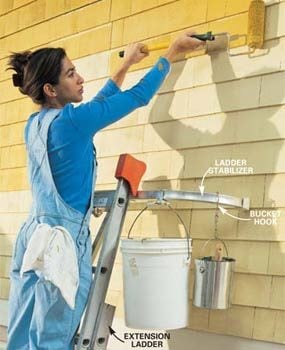
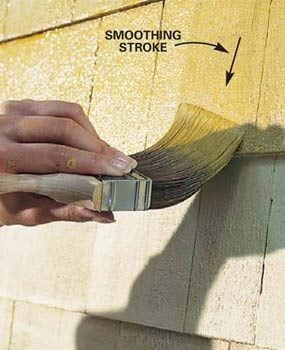

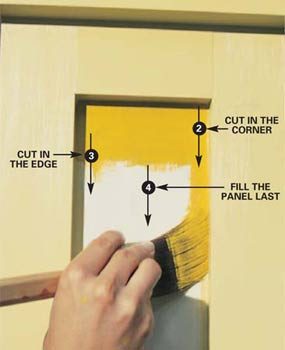
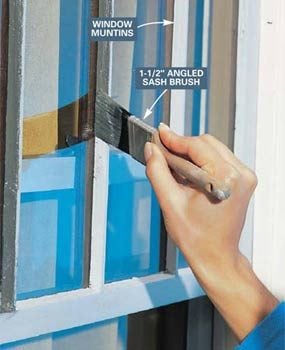

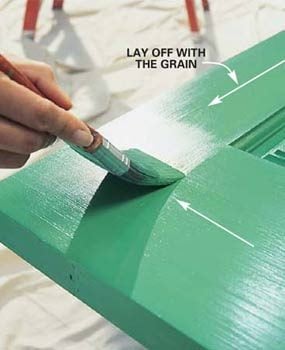
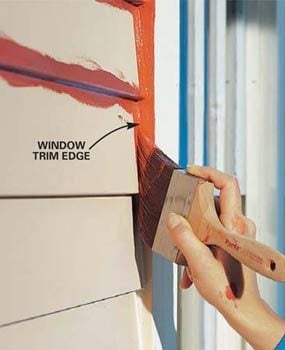



0 Response to "How To Paint Outside House Trim"
Post a Comment